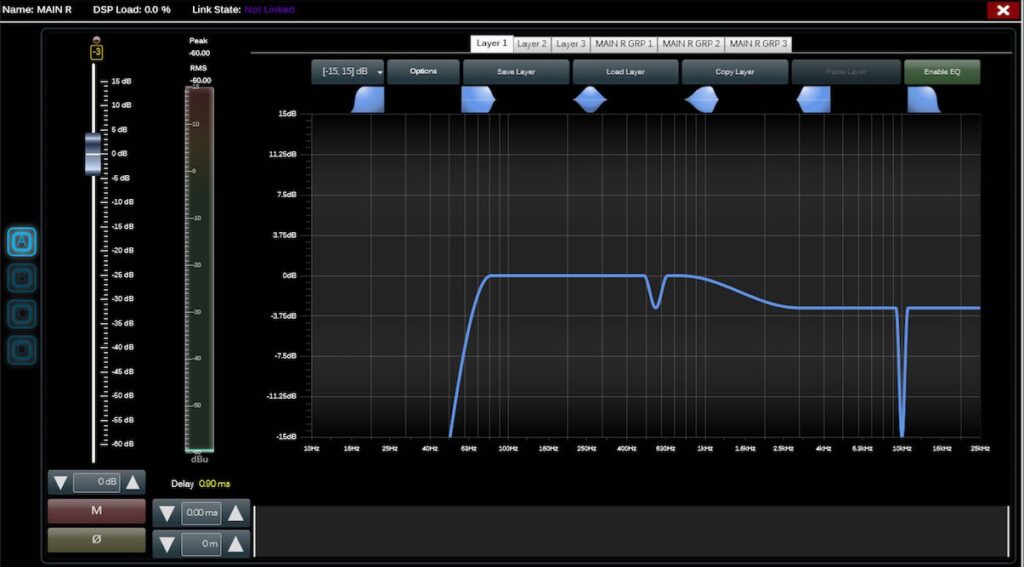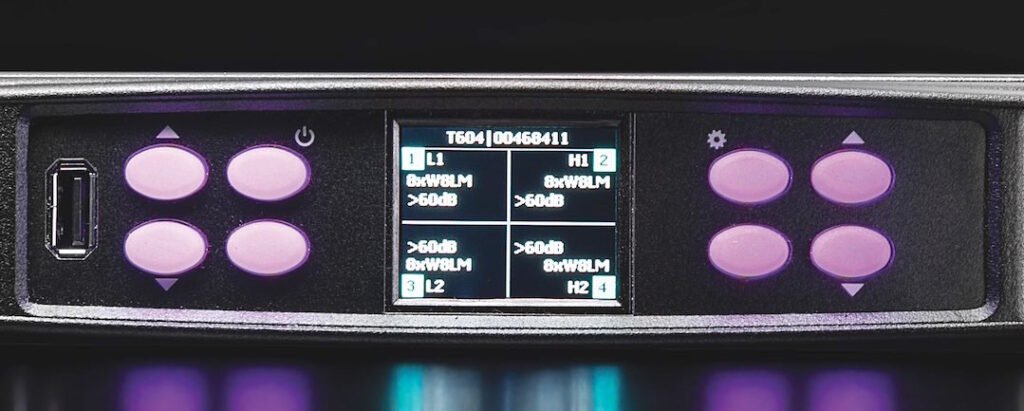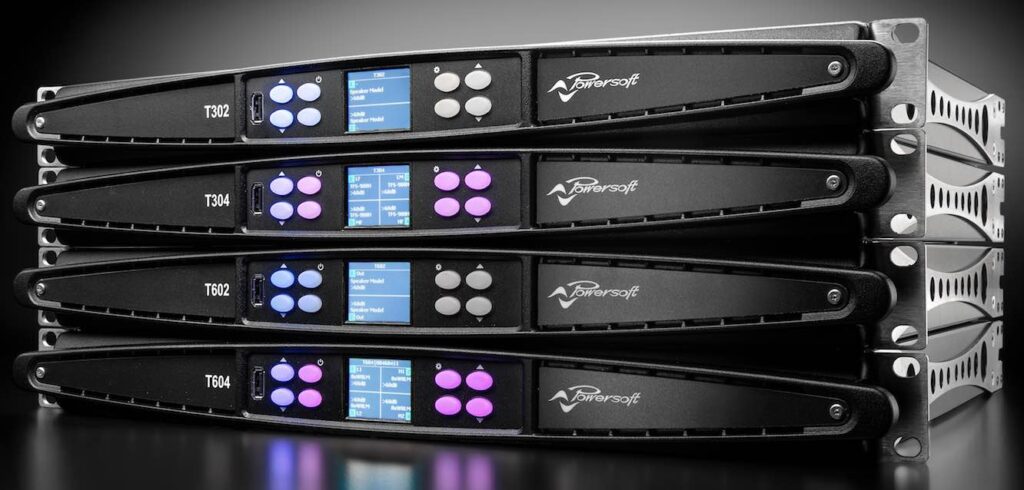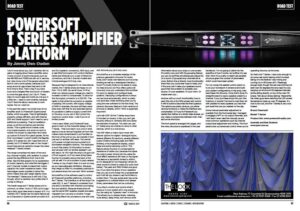News
18 Mar 2019
ROADTEST: Powersoft T Series Amplifier Platform
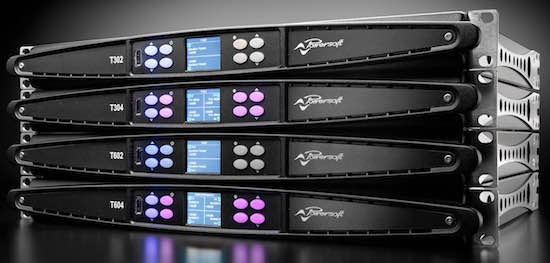
Subscribe to CX E-News
ROADTEST
Powersoft T Series Amplifier Platform
by Jimmy Den-Ouden.
I don’t know about you, but I certainly did my years of lugging about heavy amplifier racks. I know a bunch of workhorse amps such as the AM1600 and P3000 are still out in service, but I also know a lot of the people using them tend to carry some spares, because such amps are at an age where they tend to fail from time to time.
That’s okay if you have truck and a tailgate lifter and bunch of loaders to move the gear about, but I don’t. These days my sound gigs are mostly as one guy in a little van. I need to work smarter, because I don’t have the labour resources to work harder. Nor do I want to!
In the past few years I’ve turned over all my amplifier stock to Powersoft Quattrocanali Series, which are great. They’re lightweight, powerful, energy efficient, and with internal DSP and Dante support I don’t need to carry additional processing. They’re installation amps, so all the connectors are terminal blocks. This is great since it saves costs in an install scenario, but since my work is mobile I’ve chosen to case them and make up custom XLR and NL4 patch panels.
At the time I purchased I couldn’t justify the flagship option of X series (nor did I need that kind of power), but if I’d waited a year or two longer I would have almost certainly chosen the newly released T Series instead. The range comprises two each of two and four channel models, with variation in output power the big difference from one to the other.
See the little graphic for an explanation of output capacity, and note that the bigger 2 and 4 channel models increase their output capacity into lower impedance loads – they have bigger power supplies to allow this, which means they also weigh slightly more. The heaviest T Series amp is still only 7.1kg though, which is certainly very polite when it comes to lifting it.
The install range and T Series share a lot in common, so when I took a T 302 out to a gig I had a fairly good idea what to expect of it.
 In a nutshell, the T Series has the same feature set as a Duecanali or Quattrocanali but adds XLR and NL4 speakon connectors, AES input, and a neat little front panel LCD control interface. Dante and Ethernet is on a pair of EtherCon connectors, and the 2 channel models also include analogue XLR loop outs.
In a nutshell, the T Series has the same feature set as a Duecanali or Quattrocanali but adds XLR and NL4 speakon connectors, AES input, and a neat little front panel LCD control interface. Dante and Ethernet is on a pair of EtherCon connectors, and the 2 channel models also include analogue XLR loop outs.
Because they’re designed for an international market, the T Series amps are happy to run from 110 or 240V. As we all know, V=IR so when you reduce supply voltage you need to increase current to compensate. To allow for this the supply connector is a C20 IEC.
The reality is that while the connector is capable of passing 15A current, with supply voltage of 240V in Australia, the amp will likely never draw even half that for any extended period. It’s possible to define a supply current limit on the amp, so you can in fact control the maximum current draw – cute if you’re on limited power!
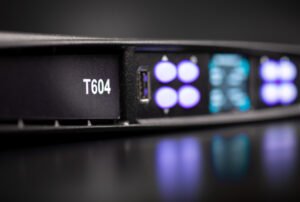 I love a sexy Italian, and Powersoft have gone to town on the industrial design of the T Series. They look damn cool, and in what seems to be an almost forgotten art form the makers have remembered to put handles on the front of the unit so you can transfer it from one rack to another with ease. The central LCD screen is bright and surrounded by 8 illuminated navigation buttons. The resolution is such that plenty of information is shown and yet even with my terrible eyesight I can still read it.
I love a sexy Italian, and Powersoft have gone to town on the industrial design of the T Series. They look damn cool, and in what seems to be an almost forgotten art form the makers have remembered to put handles on the front of the unit so you can transfer it from one rack to another with ease. The central LCD screen is bright and surrounded by 8 illuminated navigation buttons. The resolution is such that plenty of information is shown and yet even with my terrible eyesight I can still read it.
At 1RU high the amp’s not got a lot of front support, so if you were doing heavy touring I’d probably secure the back of the unit as well. It’s not a problem to pack several T series on top of each other in a rack so long as you have adequate ventilation. Because they weigh so little it’s completely practical to put several amps into one rack. Work smarter.
ArmoniaPlus is the software used to control all Powersoft amplifier platforms, including the T Series. The interface on all the amps I’ve used (QC, X, and T Series) is consistent from one amp to another with channel count being the one variation. Because these amps all use the same DSP, speaker presets are easily migrated from one amp to another.
Forget punching filters into processors over and over, with Armonia you do it only once.
ArmoniaPlus is a complete redesign of the previous generation Armonia Pro Audio Suite, and it adds new features such as array shading as well as a redesigned interface. I found Pro Audio Suite is a lot easier to wrap my head around, but Plus offers quite a bit more and once you understand the workflow it’s quick to design and configure large systems.
Deploying configurations to amps can be done automatically, which is pretty cool (and also mildly terrifying when you’re using the new software for the first time). The network discovery feature in both versions of Armonia is reliable, which I think is especially important.
Let’s talk DSP.
All the T Series amps have it included on–board, in fact you can’t get the amp without it. Similarly AES and Dante are standard inclusions. You even can use a T Series amp as a Dante on-ramp to other devices, which is a nice bonus.
The DSP offers a matrix input mixer with failover options for digital / analogue inputs, several different EQ sections, several different output limiters (including peak and RMS limiters), a live impedance display, output delay and active damping control.
This feature allows the amp to compensate for resistance of cable runs, because the higher the output power driving into the cable the more effect resistance will have on the signal. The feature is bandwidth limited to 400Hz, so it’s designed for low frequency drivers (in other words it’s there to make your subs work better).
The peak and RMS limiters are good too, if you have the specs of your speakers then you can punch these into a spreadsheet and it will tell you where to set the limiters to protect them. The user guide even has some suggestions on suitable attack and release times, parameters that can be confusing.
If you like to monitor and control what’s going on in your system all in one screen, you can setup an “operator view” in Armonia. This allows you to display levels, metering, mute status, delay times, and various other information about your amps on one screen. It’s pretty cool, and with the grouping feature you can do stuff like simultaneously adjust EQ on a bunch of grouped amp channels all at once.
Bottom line is there’s more functionality there than you could ever hope to need, and if this amp can’t make your speakers sound good then the problem is probably your source. Or your speakers. Or your room. Or maybe even you…
Anyhow with so much functionality, how to pack this into a tiny little screen and control it with 8 buttons becomes the final question. The options are pretty obvious, you either remove functions or make the interface very complicated. Or if you’re Powersoft you realise that neither is a wholly ideal answer, so you make a compromise between both, then add some shortcuts. The front panel is arranged into pages, and the menu structure is explained in the user handbook.
I’m not going to delve into the specifics of how it works, but suffice it to say that I think it’s a pretty in-depth yet sensible structure given the number of parameters which could have been added.
For my money the easiest control option is to do your homework in advance and build your system configurations in the shop, then load these into the amp. Once that’s done it’s straightforward to load a speaker preset to a channel. If you put these amps into your hire inventory, it wouldn’t be hard to load them all with presets for every speaker you had then just recall the one you needed on the day.
Some manual parameter adjustment is possible from the front panel (eg: I managed to engage a HPF on my output channels, and I still hadn’t even read the manual), as are more common operations such as channel output level adjustment and muting. The front panel locks out advanced control when you’re operating the amp via Armonia.
So that’s the T Series.
I was lucky enough to do some real world testing which involved taking it to the festival I was mixing and running my in-fill boxes off it. Pleasingly enough even though the day was stinking hot (well over 30 degrees) the amp kept its cool, capping out at around 55 degrees internally (while sitting directly on top of the main PA amps). Talk about stress testing!
Meanwhile the video guys were watching the LED screen temperature creep up over 70 degrees. It’s nice to be cool, and the T Series is very cool indeed.
Brand: Powersoft
Model: T Series
Product Info: www.powersoft-audio.com
Australia and New Zealand: www.pavt.com.au
From CX Magazine – March 2019.
CX Magazine is Australia and New Zealand’s only publication dedicated to entertainment technology news and issues – available in print and online. Read all editions for free or search our archive www.cxnetwork.com.au
© CX Media
Subscribe
Published monthly since 1991, our famous AV industry magazine is free for download or pay for print. Subscribers also receive CX News, our free weekly email with the latest industry news and jobs.



